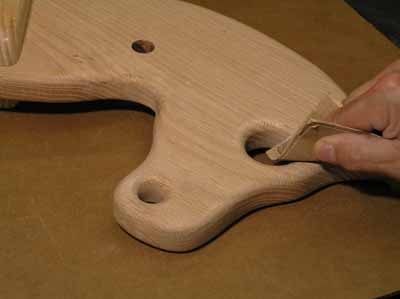Sanding
One of the most frequently used tools in my shop is an inflatable drum sander. Mine is 3 inches in diameter and 7 inches long. The advantage of this drum lies in the ability to vary the air pressure to change the firmness of the sanding surface. I use pressures between 3 and 15 pounds that I obtain with a couple of strokes on a bicycle pump. At these low pressures the sanding cloth conforms to the curved wood parts and the resulting sanded contour closely matches the original shape. These drums are available from several manufacturers and tool supply houses. (see appendix) You also have to attach this drum to a motor or drill press. If you plan a lot of work with this tool you will want to build a separate machine base for it. I use a drum from Nu-Matic Grinders (#3270) that costs $115.00. It has the advantage of soft ends while the others have rigid end caps. It also costs substantially more than the others. (about 4 times) This tool saves a lot of time and the quality of your work will improve.

Use the drum to sand all the flat surfaces and the rounded edges of the horse's parts. If I could not use an inflatable drum I would choose a vibrating pad sander. The curved edges of the horse would require a lot of hand sanding as well. Try to keep the sanding motion parallel to the wood grain as much as possible. Sanding scratches across the grain are far more visible than those parallel to the grain when you apply oil or varnish to your work. Be careful not to sand the sharp non-rounded edges, especially the ends of the legs and cross pieces. Keeping these edges sharp gives a much higher quality appearance in the finished horse. You might start with a 120 grit sandpaper and then use a 220 grit and a 320 grit. Care taken here has a big payoff in the final horse.


The horse's rounded over eye and nostril need hand sanding, or perhaps finger sanding. These are the first places children explore with their fingers; take some time.

You might wonder that I recommend so much sanding before assembly. Hardwood routed surfaces can be rough with tiny chip outs. Smoothing rounded shapes like these can require a lot of wood removal. Sanding the parts individually allows you to better use your sanding machines and prevent cross grain scratching of adjacent pieces than when sanding after assembly. Hand sanding hardwood routed surfaces is very time consuming and exhausting. Use your machines as much as possible.
Workmanship is the application of technique to making, by the exercise of care, judgment, and dexterity. As opposed to design, workmanship is what for practical purposes the designer cannot give effective instructions about by drawings or words, although he can envisage it perfectly well. The designer is apt to imagine he has more control over workmanship than he has.
The Nature and Art of Workmanship
David Pye
...and it was after long searching that I found a carpenter's chest, which was indeed a very useful prize to me, and much more valuable than a ship loading of gold.
Daniel Defoe
Being thus prepared for us in all ways, and made beautiful, and good for food, and for building, and for instruments of our hands, this race of plants, deserving boundless affection and admiration from us, becomes, in proportion to their obtaining it, a nearly perfect test of our being in right temper of mind and way of life; so that no one can be far wrong in either who
loves trees enough, and everyone is assuredly wrong in both who does not love them, if his life has brought them in his way.
John Ruskin, 1819-1900, Modern Painters VI
Wood is universally beautiful to man. It is the most humanly intimate of all materials.
Man loves his association with it: likes to feel it under his hand, sympathetic to his touch and his eye.
Frank Lloyd Wright
Architectural Record – May 1928
